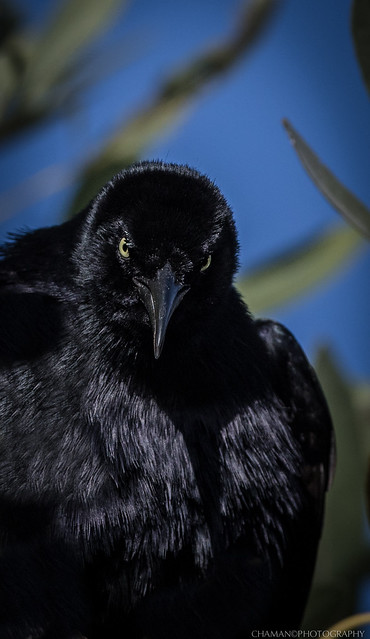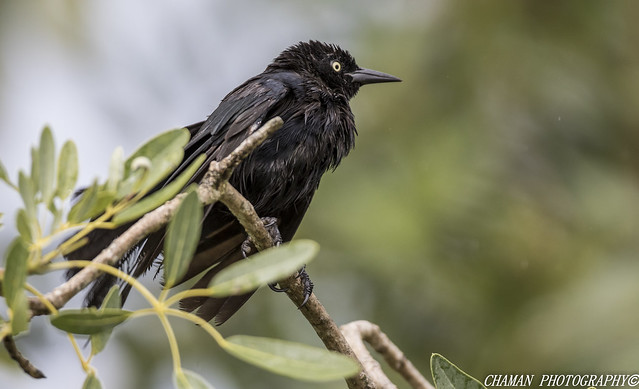Photographing A Black Horse
Jun 3, 2016 22:39:49 #
A friend of mine has asked me to photograph her horse . He is a very black horse and would like ask what settings to use to get as much detail as possible. Supposed to be a bright day and will be taken in pasture not a dirt rink and will be using 7D11 with 18-300 Sigma.
Jun 3, 2016 22:55:14 #
Jun 3, 2016 23:22:59 #
I would recommend trying to shoot the horse not in a bright day but maybe try for an overcast one or better yet very early or evening to catch more soft light conditions. If it is a too bright day a very dark subject like this horse could create a lot of specular highlights which will lack details by definition.
Look at this example from one of my images:
 LY2A0238-2 by Oscar Baez Soria, on Flickr
LY2A0238-2 by Oscar Baez Soria, on Flickr
Its a very dark bird in a very bright day. Very black subjects like this tend to give off this incredibly sharp and bright highlights which may kill the desire of obtaining as much details as possible which your friend wanted. Now look at a similar bird in an overcast day with softer light:
 LY2A4813 by Oscar Baez Soria, on Flickr
LY2A4813 by Oscar Baez Soria, on Flickr
Look how much detail can be obtain in this situation. You can see the different tonal ranges and feather detail much more clearly. Hope this helps in your quest for a good image.
Look at this example from one of my images:
 LY2A0238-2 by Oscar Baez Soria, on Flickr
LY2A0238-2 by Oscar Baez Soria, on FlickrIts a very dark bird in a very bright day. Very black subjects like this tend to give off this incredibly sharp and bright highlights which may kill the desire of obtaining as much details as possible which your friend wanted. Now look at a similar bird in an overcast day with softer light:
 LY2A4813 by Oscar Baez Soria, on Flickr
LY2A4813 by Oscar Baez Soria, on FlickrLook how much detail can be obtain in this situation. You can see the different tonal ranges and feather detail much more clearly. Hope this helps in your quest for a good image.
Jun 4, 2016 02:56:39 #
I'm shooting horses tomorrow(Saturday), I'll find a black one and let you know what works best!
You can spot-meter, or use an average meter and add +1/3 to +2/3 EC. Should work fine.
Of course a bit of fill flash would probably be best. ;-)
SS
You can spot-meter, or use an average meter and add +1/3 to +2/3 EC. Should work fine.
Of course a bit of fill flash would probably be best. ;-)
SS
Jun 4, 2016 03:54:34 #
chaman wrote:
I would recommend trying to shoot the horse not in... (show quote)
OP - please listen to chaman and disreguard rongobongos post.
I haven't read the rest of the replies, but be careful who's info you listen to. When someone provides examples that are good quality, it is a no brainer. Good luck with the shoot and do try early or late in the day.
Jun 4, 2016 04:55:55 #
tdekany wrote:
OP - please listen to chaman and disreguard rongobongos post.
I haven't read the rest of the replies, but be careful who's info you listen to. When someone provides examples that are good quality, it is a no brainer. Good luck with the shoot and do try early or late in the day.
I haven't read the rest of the replies, but be careful who's info you listen to. When someone provides examples that are good quality, it is a no brainer. Good luck with the shoot and do try early or late in the day.
Well...that would be a mistake.
Sure Ron is abrupt and comes across rude much of the time but just like real life; evaluate the content of the statement not the delivery method.
He's correct in that it doesn't matter what color you are trying to photograph, if you meter for the light "falling on" an object instead of the light "reflecting from" an object, you will get correct exposure no matter if it's a black horse, white horse or blue horse.
To flesh out what Ron meant; either buy a simple light meter (the best solution in the long run) or put the camera in Manual mode and meter off of a grey card in the same light the horse is in and set the camera to those settings.
In a pinch metering off of the palm of your hand and opening up one stop works great too.
Jun 4, 2016 06:19:36 #
Jun 4, 2016 06:23:22 #
MTG44 wrote:
A friend of mine has asked me to photograph her horse . He is a very black horse and would like ask what settings to use to get as much detail as possible. Supposed to be a bright day and will be taken in pasture not a dirt rink and will be using 7D11 with 18-300 Sigma.
Rongnongno and Rpavich have the science correct and know something about light and metering. And you may get other ideas from others to try.
Also I don't think there would be anything wrong with trying to photograph the horse under a few lighting conditions. Also it would not hurt to bracket widely, -3EV, -2EV, -1EV, 0, +1EV, +2EV, +3EV, you are not shooting film. Then you are bound to get some great exposures. You can probably set your camera to Auto-bracket. That would work great for shots if the horse is not moving rapidly. To summarize my second paragraph: Taking a few test shots won't hurt!



Horses are beautiful animals.


Jun 4, 2016 06:24:18 #
Jun 4, 2016 06:37:20 #
SharpShooter wrote:
I'm shooting horses tomorrow(Saturday), I'll find a black one and let you know what works best!
You can spot-meter, or use an average meter and add +1/3 to +2/3 EC. Should work fine.
Of course a bit of fill flash would probably be best. ;-)
SS
You can spot-meter, or use an average meter and add +1/3 to +2/3 EC. Should work fine.
Of course a bit of fill flash would probably be best. ;-)
SS
Shouldn't it be negative EC? Camera meter will read horse and try to make it middle gray.
Read off open palm/open up one stop is a good approach.
Jun 4, 2016 07:06:54 #
tdekany is correct, be careful who's info you listen to....and rpavich is also correct, don't listen to tdekany.......
Jun 4, 2016 07:07:41 #
Jun 4, 2016 07:35:00 #
MTG44 wrote:
Thanks for all your suggestions. I will let you know it comes out.
Please do. It's a learning curve and keeping at it and trying and/or failing is part of figuring things out.
Jun 4, 2016 08:00:44 #
MTG44 wrote:
A friend of mine has asked me to photograph her horse . He is a very black horse and would like ask what settings to use to get as much detail as possible. Supposed to be a bright day and will be taken in pasture not a dirt rink and will be using 7D11 with 18-300 Sigma.
Isn't this place wonderful? You get conflicting advice and then a cat fight breaks out over whom to listen to! Information and entertainment at no cost...



If you can auto bracket on your Canon, then do so. It'll certainly get you a good exposure.
Jun 4, 2016 08:04:05 #
clansman
Loc: wendover,england
SharpShooter wrote:
I'm shooting horses tomorrow(Saturday), I'll find a black one and let you know what works best!
You can spot-meter, or use an average meter and add +1/3 to +2/3 EC. Should work fine.
Of course a bit of fill flash would probably be best. ;-)
SS
You can spot-meter, or use an average meter and add +1/3 to +2/3 EC. Should work fine.
Of course a bit of fill flash would probably be best. ;-)
SS
May I respectfully suggest that if intending to use fill-in flash , you tread carefully in case it spooks the horse. He/she may seem quite docile and happy to take it full face as one of mine did, (probably because trust between us was absolute, whereas the cat who had inveigled himself into the shot was literally gone in the flash) but best to check with the owner first. Otherwise, hope to see the pix.
If you want to reply, then register here. Registration is free and your account is created instantly, so you can post right away.










